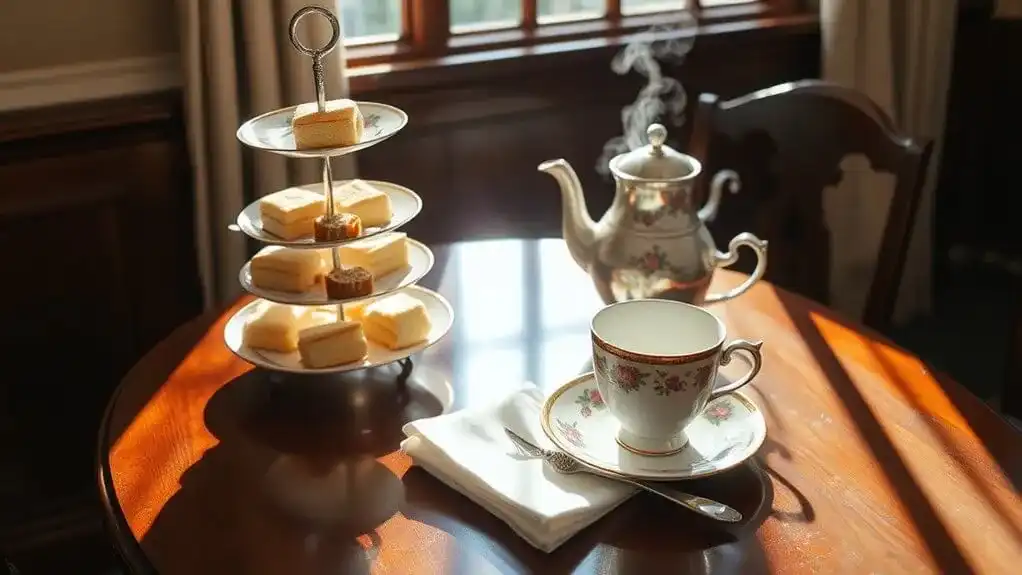English Breakfast tea isn't originally English at all – it's Scottish. The blend was created by Scottish tea master Drysdale in the early 1800s, combining teas from Assam, Ceylon, and Keemun. It only became "English" when Queen Victoria fell in love with it during her stays at Balmoral Castle and brought it back to England. Her royal endorsement transformed this robust morning blend into a British cultural icon. The story behind this beloved brew holds even more surprising twists.
Key Points
- Queen Victoria popularized the blend in England after discovering it at Balmoral Castle, leading to its "English" name designation.
- Despite Scottish origins, the tea gained its identity through widespread adoption in English society across all social classes.
- The blend's robust flavor suited English industrial workers, making it a staple during Britain's Industrial Revolution.
- Royal endorsement, particularly through Queen Victoria and Twinings' royal warrant, cemented the tea's English cultural identity.
- The tea's adaptation to English customs, including milk and sugar additions, helped establish it as a distinctly English beverage.
The Scottish Origins of an English Classic
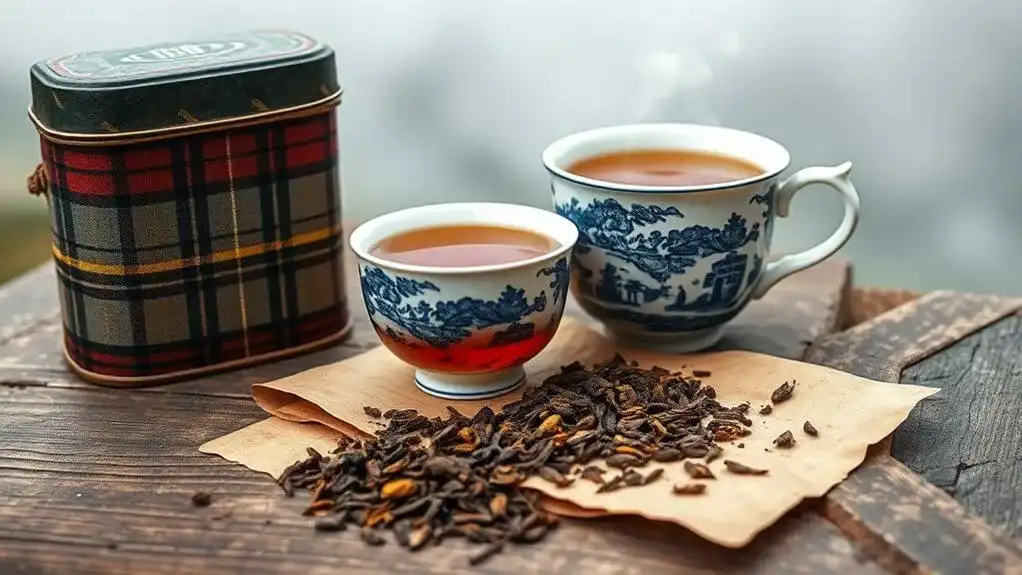
While many associate English Breakfast tea with British tradition, its origins actually trace back to Scotland in the early 19th century. A Scottish tea master named Drysdale created this distinctive blend, marking the beginning of its rich Scottish heritage. Through careful tea blending, he combined robust black teas from Assam, Ceylon, and occasionally Keemun to create a full-bodied morning beverage. Initially, tea was a luxury item exclusively enjoyed by wealthy families. The tea's journey to becoming an "English" breakfast staple was largely influenced by Queen Victoria's fondness for it during her stays at Balmoral Castle in Scotland. Her royal endorsement helped spread its popularity throughout the United Kingdom, eventually leading to its adoption in England. Despite its name, this hearty blend's Scottish roots remain an essential part of its story, highlighting the complexity of British tea culture. The blend gained significant commercial success when it was introduced to America, where it was sold for fifty cents per pound in 1843. Today, the tea is celebrated for its malty notes and deep aromas that complement a traditional morning meal.
The American Influence on English Tea Culture

Although tea symbolizes British culture today, the American colonies played a pivotal role in shaping England's tea trade and traditions. American Tea Adaptation flourished in the 1700s as colonists enthusiastically imported British tea and embraced Colonial Tea Customs, mirroring the sophistication of their British relatives. Tea drinking became so widespread that tea vendors were established in Boston as early as 1690. A notable development came when Richard Davies created the first English Breakfast blend in New York City in 1843.
This harmonious relationship changed dramatically when Parliament imposed taxes without colonial representation in 1767. The resulting tensions culminated in the Boston Tea Party, where colonists dumped 90,000 pounds of British tea into Boston Harbor. This act of defiance, along with widespread tea smuggling, forced Britain to reassess its tea trade policies. While the American Revolution ultimately created a divide between American and British tea cultures, the colonies' influence on British tea trade remains an essential part of the beverage's history. In fact, English Breakfast tea itself was first created by American tea dealers who aimed to complement hearty breakfast foods in the late 19th century.
Queen Victoria's Royal Seal of Approval
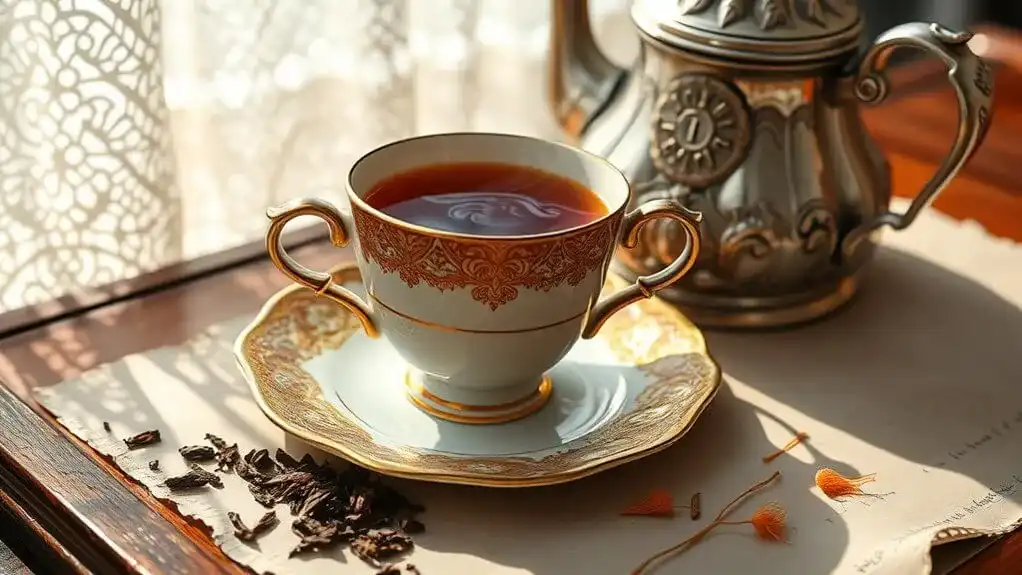
During her visit to Balmoral Castle in Scotland, Queen Victoria's chance encounter with a robust morning blend would forever change British tea culture. After trying what was then simply called "Breakfast Tea," she was so impressed that she brought it back to England, inadvertently giving rise to its now-famous name: English Breakfast Tea. Twinings would later launch their own English Breakfast blend in 1933 to perfectly complement morning meals. The Queen's preferences extended beyond this morning blend. She particularly enjoyed Earl Grey and Darjeeling, and her exacting standards for tea preparation were legendary – she'd reportedly throw unsatisfactory cups across the room. Tea was often served in grand formal settings with immaculate lace doilies and fine China on display. Under her reign, tea traditions flourished, especially after she embraced the afternoon tea custom initiated by the Duchess of Bedford. Her royal warrant to Twinings in 1837 cemented the relationship between the monarchy and Britain's tea culture, an influence that continues today. Her extraordinary influence on tea culture is reflected in prestigious blends like the Queen Victoria Blend, which combines premium Assam, Darjeeling, and Ceylon teas.
The Art of Blending British Morning Tea
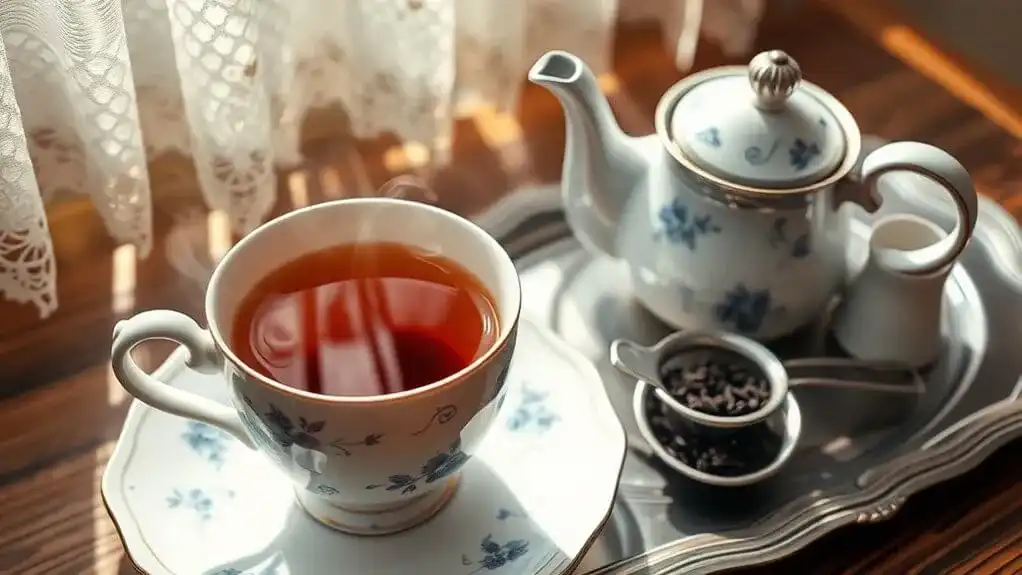
Behind every perfect cup of English Breakfast tea lies a sophisticated art of blending that dates back to the 19th century. Tea masters carefully select and combine up to 50 different varieties of black tea leaves to create distinct flavor profiles that capture the essence of a traditional British morning brew. A classic blend often combines three black teas including Yunnan, Keemun, and Assam varieties for a balanced flavor. Most producers utilize the CTC method for English Breakfast teas to ensure quick brewing and strong flavor extraction.
The blending techniques involve precise ratios and gentle mixing to preserve the integrity of the leaves. Tea artisans combine varieties in specific proportions, such as two parts of one tea to one part of another, ensuring a consistent and balanced taste. Each blend undergoes rigorous testing until it achieves the desired strength and complexity. The final product must deliver the robust, full-bodied character that's become synonymous with English Breakfast tea. Once perfected, the leaves are sorted by size to guarantee uniform brewing quality. Proper brewing requires just below boiling water temperatures to extract the optimal flavors from these carefully crafted blends.
From Luxury to Working Class: Tea's Social Evolution
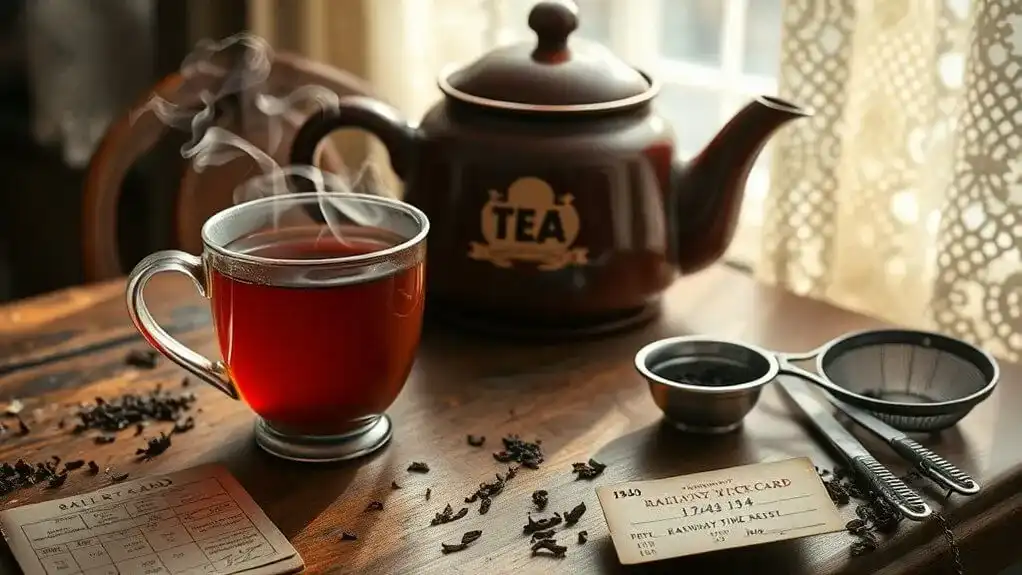
While tea holds a permanent place in British culture today, its journey from an exclusive luxury to a universal beverage spans several fascinating decades. Initially reserved for society's elite in the mid-17th century, tea's accessibility dramatically shifted during the Industrial Revolution. The 1840s marked a turning point as class distinctions began to blur around tea rituals, especially when the Duchess of Bedford popularized afternoon tea. A New York apothecary named Richard Davies made history when he secured import credit to create his original English Breakfast blend.
Tea merchants played a significant role in this democratization by creating affordable blends, including English Breakfast tea, which combined leaves from various regions of the British Empire. The rise of tea shops and vendors made these blends readily available to working-class citizens. The blend's unique combination of Assam and Ceylon teas created a distinctively robust flavor profile that appealed to all social classes. The full-bodied nature of English Breakfast tea made it particularly suitable for complementing hearty morning meals. This transformation turned tea from a symbol of status into a unifying force in British society, transcending social boundaries.
A Tale of Three Tea Regions: Assam, Ceylon, and Kenya
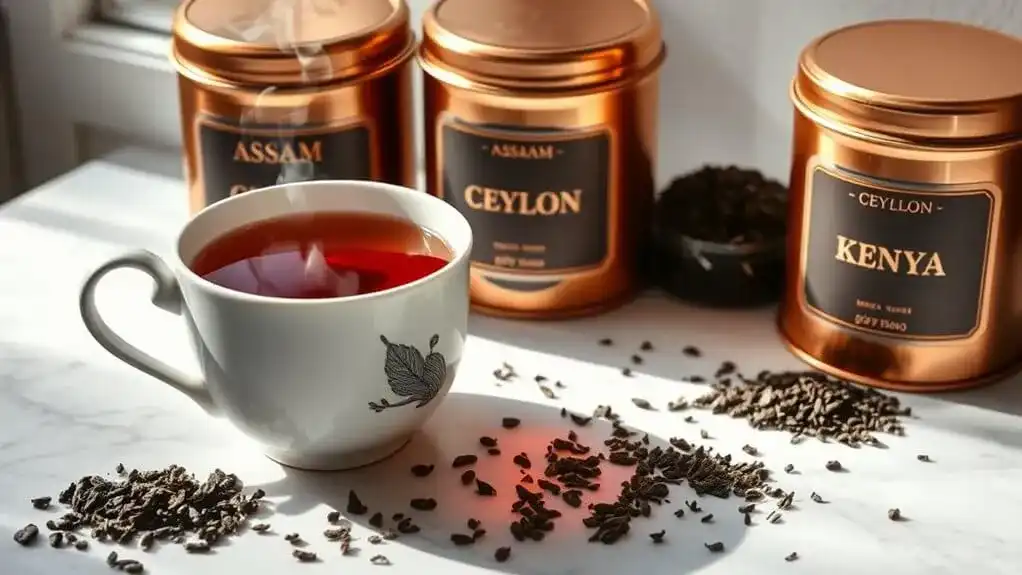
The artistry of English Breakfast tea lies in the masterful blending of leaves from three distinct regions: Assam, Ceylon, and Kenya. Assam characteristics include bold, malty flavors that develop from India's tropical monsoon climate and high temperatures. The region's tea estates produce over 507 million kilograms annually, making it the world's largest tea-growing area. Ceylon processing involves careful hand-plucking and high-altitude production, creating full-bodied teas with a subtle malty character. Our Ceylon tea is carefully selected as Orange Pekoe grade for superior quality. While Kenyan flavor contributions aren't as extensively documented, they're essential in creating the robust English Breakfast blend. English blending traditions combine these three origins to achieve the perfect balance – Assam's strength, Ceylon's refinement, and Kenya's complementary robust notes create the quintessential breakfast tea that's become a global favorite. The tradition of Ceylon tea began after coffee rust disease devastated Sri Lanka's coffee plantations in 1869. The deep reddish-brown color of Assam tea adds a rich visual appeal to the classic English Breakfast blend.
The British Industrial Revolution's Tea Legacy

During Britain's Industrial Revolution, tea transformed from a luxury commodity into an essential cornerstone of working-class life. Factory owners recognized tea's stimulating properties and its positive impact on worker productivity, leading them to introduce formal tea breaks. As prices fell and availability increased, tea consumption spread rapidly across all social classes. The addition of sugar and milk became standard practice by the early 1700s, establishing the classic British way of enjoying tea.
The Industrial Revolution's tea culture shaped modern British society in several key ways:
- Tea provided a safer alternative to alcohol, helping maintain a more reliable workforce
- Factory tea breaks became a crucial social institution, boosting morale and energy
- The combination of warm, sweet tea and calories helped workers endure long shifts
- Lower mortality rates emerged as people boiled water for tea, inadvertently creating a safer beverage
This transformation made tea an indispensable part of British industrial society, forever changing how the nation worked and socialized.
Regional Breakfast Tea Wars: English Vs Irish Vs Scottish

Across the British Isles, three distinct breakfast tea traditions have evolved into friendly rivals, each claiming superiority in strength, flavor, and cultural significance. These tea blend variations reflect unique regional preferences that have developed over centuries.
English Breakfast Tea stands out as the lightest and smoothest of the trio, featuring a balanced mix of Assam, Ceylon, and sometimes Keemun teas. It's characterized by malty notes with hints of pine and citrus. Queen Victoria's royal endorsement helped establish this blend as a British staple. Irish Breakfast Tea packs a stronger punch, dominated by robust Assam leaves that create a deep, malty profile. The traditional brewing method enhances its rich flavor characteristics. The boldest of all is Scottish Breakfast Tea, which emphasizes Assam even further, resulting in a powerful woody and smoky taste. While all three can be enjoyed with milk and sugar, their distinct personalities continue to spark spirited debates about which truly reigns supreme. Though originally created for morning consumption, these teas are now consumed throughout the day by tea enthusiasts worldwide.
The Science Behind the Perfect Morning Brew
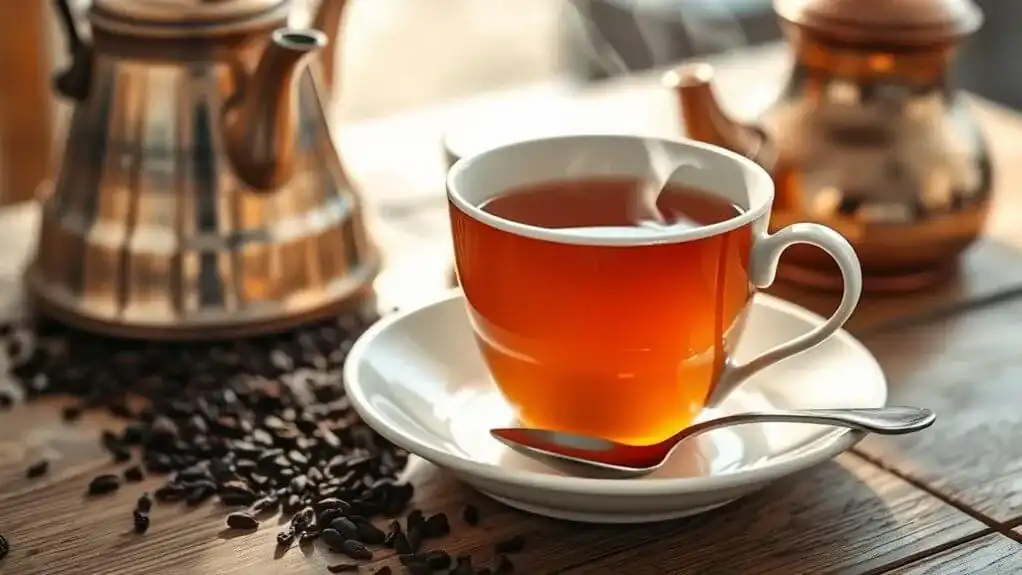
While creating the perfect cup of English Breakfast Tea might seem simple, brewing this complex blend requires precise attention to scientific principles. The combination of tea varieties from Assam, Ceylon, Keemun, and Kenya creates a dynamic flavor profile that's enhanced through specific brewing methods. When steeped for 3-5 minutes in freshly boiled water, the tea releases its ideal caffeine content of 42mg and reveals its full-bodied, coppery-red characteristics. Many tea enthusiasts achieve their desired taste by adding milk or honey to complement the robust flavors.
Key factors that influence the perfect morning brew:
- Water temperature affects the extraction of flavonoids and antioxidants
- Steeping time determines caffeine content and flavor intensity
- Water quality impacts the tea's natural malty and citrus notes
- Tea-to-water ratio controls the brew's strength and body
The science behind this beloved blend guarantees a consistent, energizing start to any day.
Conclusion
English Breakfast tea isn't particularly English at all, but it's become deeply woven into Britain's cultural fabric. While today's tea drinkers enjoy approximately 100 million cups of English Breakfast tea each day in the UK alone, the blend's origins trace back to Scottish tea masters and colonial trade routes. It's a demonstration of how marketing, royal endorsement, and cultural adoption can transform an international product into a national symbol.


